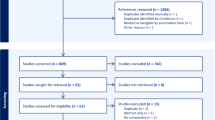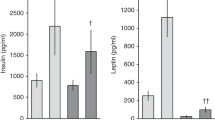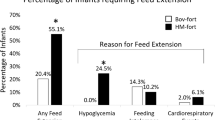Abstract
Objective
The purpose of this study was to determine whether a point-of-care osmotic device concentrates important human milk (HM) nutrients to support feeding neonates requiring high-nutrient, low-volume feedings.
Study design
Raw and pasteurized HM samples were concentrated to determine the effects of time and temperature on concentration. Concentrated samples were compared with matched baseline samples to measure changes in selected nutrient concentrations. Furthermore, changes in concentration of certain bioactive components of raw milk samples were measured.
Result
The device significantly increased the concentrations of the majority of the measured nutrient and bioactive levels (p < 0.05). Increasing temperature of HM from 4 to 37 °C increased the concentration rate >30%. In all cases, the concentration rate of pasteurized HM was greater than that of raw HM.
Conclusions
The osmotic concentration of HM is a promising option for neonatal nutrition. Further studies are needed to establish an evidence base for the practical applications of this point-of-care device.
This is a preview of subscription content, access via your institution
Access options
Subscribe to this journal
Receive 12 print issues and online access
$259.00 per year
only $21.58 per issue
Buy this article
- Purchase on Springer Link
- Instant access to full article PDF
Prices may be subject to local taxes which are calculated during checkout



Similar content being viewed by others
References
Ballard O, Morrow AL. Human milk composition. Pediatr Clin North Am. 2013;60:49–74.
Meier PP, Patel AL, Esquerra-Zwiers A. Donor human milk update: evidence, mechanisms and priorities for research and practice. J Pediatrics. 2017;180:15–21.
Bertino E, Giuliani F, Occhi L, Coscia A, Tonetto P, Marchino F, et al. Benefits of donor human milk for preterm infants: current evidence. Early Hum Dev. 2009;85:S9–10.
Moro GE, Arslanoglu S, Bertino E, Corvaglia L, Montirosso R, Picaud JC, et al. XII. Human milk in feeding premature infants: consensus statement. J Pediatr Gastroenterol Nutr. 2015;61:S16–9.
Bauer J, Gerss J. Longitudinal analysis of macronutrients and minerals in human milk produced by mothers of preterm infants. Clin Nutr. 2011;30:215–20.
Hay WW, Thureen P. Protein for preterm infants: how much is needed? How much is enough? How much is too much? Pediatr Neonatol. 2010;51:198.
Schanler RJ, Lau C, Hurst NM, Smith EO. Randomized trial of donor human milk versus preterm formula as substitutes for mothers’ own milk in feeding of extremely premature infants. Pediatrics. 2005;116:400–6.
García-Lara NR, Escuder-Vieco D, García-Algar O, De la Cruz J, Lora D, Pallás- Alonso C. Effect of freezing time on macronutrients and energy content of breastmilk. Breastfeed Med. 2012;7:295–301.
Fusch G, Rochow N, Choi A, Fusch S, Poeschl S, Ubah AO, et al. Rapid measurement of macronutrients in breast milk: how reliable are infrared milk analyzers?. Clin Nutr. 2015;34:465–76.
Smilowitz JT, Gho DS, Mirmiran M, German JB, Underwood MA. Rapid measurement of human milk macronutrients in the neonatal intensive care unit: accuracy and precision of Fourier transform mid-infrared spectroscopy. J Hum Lactation. 2014;30:180–9.
Herrmann K, Carroll K. An exclusively human milk diet reduces necrotizing enterocolitis. Breastfeed Med. 2014;9:184–90.
Quigley M, Embleton ND, McGuire W. Formula versus donor breast milk for feeding preterm or low birth weight infants. Cochrane Database Syst Rev. 2018.
Johnson TJ, Patel AL, Bigger HR, Engstrom JL, Meier PP. Cost savings of human milk as a strategy to reduce the incidence of necrotizing enterocolitis in very low birth weight infants. Neonatology. 2015;107:271–6.
Pammi M, Cope J, Tarr PI, Warner BB, Morrow AL, Mai V, et al. Intestinal dysbiosis in preterm infants preceding necrotizing enterocolitis: a systematic review and meta- analysis. Microbiome. 2017;5:31.
Sherman MP, Miller MM, Sherman J, Niklas V. Lactoferrin and necrotizing enterocolitis. Curr Opin Pediatr. 2014;26:146–50.
Parra-Llorca A, Gormaz M, Alcantara C, Cernada M, Nunez-Ramiro A, Vento M, et al. Preterm Gut microbiome depending on feeding type: significance of donor human milk. Front Microbiol. 2018;9:1376.
Gregory KE, Samuel BS, Houghteling P, Shan G, Ausubel FM, Sadreyev RI, et al. Influence of maternal breast milk ingestion on acquisition of the intestinal microbiome in preterm infants. Microbiome. 2016;4:68.
Sherman MP, Zaghouani H, Niklas V. Gut microbiota, the immune system, and diet influence the neonatal gut-brain axis. Pediatr Res. 2015;77:127–35.
Collado MC, Cernada M, Neu J, Perez-Martinez G, Gormaz M, Vento M. Factors influencing gastrointestinal tract and microbiota immune interaction in preterm infants. Pediatr Res. 2015;77:726–31.
Lemas D, Young B, Baker P, Tomczik A, Soderborg TL, Hernandez T, et al. Alterations in human milk leptin and insulin are associated with early changes in the infant intestinal microbiome. Am J Clin Nutr. 2016;103:1291–300.
Arslanoglu S, Boquien CY, King C, Lamireau D, Tonetto P, Barnett D, et al. Fortification of human milk for preterm infants: update and recommendations of the European Milk Bank Association (EMBA) Working Group on Human Milk Fortification. Front Pediatr. 2019;7:76.
Peila C, Moro GE, Bertino E, Cavallarin L, Giribaldi M, Giuliani F, et al. The effect of holder pasteurization on nutrients and biologically active components in donor human milk: a review. Nutrients. 2016;8:477.
Marx C, Bridge R, Wolf AK, Rich W, Kim JH, Bode L. Human milk oligosaccharide composition differs between donor milk and mother’s own milk in the NICU. J Hum Lactation. 2014;30:54–61.
Johnson TJ, Patel AL, Bigger HR, Engstrom JL, Meier P. Economic benefits and costs of human milk feedings: a strategy to reduce the risk of prematurity-related morbidities in very-low-birth-weight infants. Adv Nutr. 2014;5:207–12.
Young BE, Borman L, Heinrich R, Long J, Pinney S, Westcott J, et al. Effect of pooling practices and time postpartum of milk donations on the energy, macronutrient and zinc concentrations of resultant donor human milk pools. J Pediatrics. 2019;214:54–5.
John A, Sun R, Maillart L, Schaefer A, Hamilton Spence E, Perrin MT. Macronutrient variability in human milk from donors to a milk bank: implications for feeding preterm infants. PLoS ONE. 2019;14:e0210610.
Sauer CW, Boutin MA, Kim JH. Wide variability in caloric density of expressed human milk can lead to major underestimation or overestimation of nutrient content. J Hum Lactation. 2016;33:341–50.
Cong X, Judge M, Xu W, Diallo A, Janton S, Brownell EA, et al. Influence of feeding type on gut microbiome development in hospitalized preterm infants. Nurs Res. 2017;66:123–33.
Ganapathy V, Hay JW, Kim JH. Costs of necrotizing enterocolitis and cost-effectiveness of exclusively human milk-based products in feeding extremely premature infants. Breastfeed Med. 2012;7:29–37.
Johnston M, Landers S, Noble L, Szucs K, Viehmann L. Section on Breastfeeding. Breastfeeding and the use of human milk. Pediatrics. 2012;129:e827–41.
Boquien CY. Human milk: an ideal food for nutrition of preterm newborn. Front Pediatrics. 2018;6:295.
Gidrewwicz DA, Fenton TR. A systematic review and meta-analysis of the nutrient content of preterm and term breast milk. BMC Pediatrics. 2014;14:216.
Chang JC, Chen CH, Fang LJ, Tsai CR, Chang YC, Wang TM. Influence of prolonged storage process, pasteurization, and heat treatment on biologically active human milk proteins. Pediatrics Neonatol. 2013;54:360–6.
Triantis V, Bode L, Van, Neerven RJ. Immunological effects of human milk oligosaccharides. Front Pediatrics. 2018;6:190.
Cong X, Xu W, Janton S, Henderson WA, Matson A, McGrath JM, et al. Gut microbiome developmental patterns in early life of preterm infants: impacts of feeding and gender. PLoS ONE. 2016;11:e0152751.
Briere CE, McGrath JM, Jensen T, Matson A, Finck C. Breast milk stem cells: current science and implications for preterm infants. Adv Neonatal Care 2016;16:410–9.
Hård AL, Nilsson AK, Lund AM, Hansen-Pupp I, Smith L, Hellström A. Review shows that donor milk does not promote the growth and development of preterm infants as well as maternal milk. Acta Paediatrica. 2019;108:998–1007.
Bjelakovic L, Kocic G, Cvetkovic T, Stojanovic D, Najmen S, Jevtovic T. et al. Arginase activity in human milk during the first month of lactation. J Basic Clin Physiol Pharm. 2010;21:187–200.
Baldeón ME, Mennella JA, Flores N, Fornasini M, San Gabriel A. Free amino acid content in breast milk of adolescent and adult mothers in Ecuador. SpringerPlus. 2014;3:104.
Zhang Z, Adelman AS, Rai D, Boettcher J, Lőnnerdal B. Amino acid profiles in term and preterm human milk through lactation: a systematic review. Nutrients. 2013;5:4800–21.
Zhu J, Dingess KA. The functional power of the human milk proteome. Nutrients. 2019;11:1834.
Briassouli E, Briassoulis G, Cuany D, Sanchez-Bridge B, Longet K, Bertschy E, et al. Glutamine randomized studies in early life: the unsolved riddle of experimental and clinical studies. Clin Dev Immunol. 2012:2012;749189.
Giuffrida F, Austin S, Cuany D, Sanchez-Bridge B, Longet K, Bertschy E, et al. Comparison of macronutrient content in human milk measured by mid-infrared human milk analyzer and reference methods. J Perinatol. 2019;39:497–503.
Ellis ZM, Tan HSG, Embleton ND, Sangild PT, van Elburg RM. Milk feed osmolality and adverse events in newborn infants and animals: a systematic review. Arch Dis Child Fetal Neonatal Ed. 2019;104:F333–40.
Acknowledgements
We thank Dr. Naomi Bar-Yam of Mothers’ Milk Bank Northeast, Laraine Lockhart Borman of Mother’s Milk Bank of Colorado, Maryanne Perrin, the Human Milk Bank Association of North America Research Committee and the generous mothers who donated their milk. Funding was provided by the Colorado Office of Economic Development and International Trade. This work was also supported by the National Institute of Health Grants R01HD079404 (LDB) and S10OD023553 (LDB). The Human Milk Concentration device is not commercially available at the time of submission; this medical device is pre-FDA release to market, currently available only for research.
Author information
Authors and Affiliations
Corresponding author
Ethics declarations
Conflict of interest
Mother’s Milk Is Best (MMIB) Inc. is a neonatal medical device development company, that is pre-revenue and the HMC device process is pre-market and patent pending. MMIB Inc. was cofounded by ERS and ERN. MMIB Inc. has no corporate sponsors or partners. In 2019, MMIB Inc. received Phase I Small Business Innovation Research funding from the National Institute of Health for research in progress at the time of this submission. This research is independent of and does not reflect the views and beliefs of the UCHealth System, ERS’s NICU employer in Colorado. None of the university affiliated researchers who performed human milk nutrient analysis in this study have any equity or ownership of MMIB Inc. or other known conflicts of interest.
Additional information
Publisher’s note Springer Nature remains neutral with regard to jurisdictional claims in published maps and institutional affiliations.
Rights and permissions
About this article
Cite this article
Schinkel, E.R., Nelson, E.R., Young, B.E. et al. Concentrating human milk: an innovative point-of-care device designed to increase human milk feeding options for preterm infants. J Perinatol 41, 582–589 (2021). https://doi.org/10.1038/s41372-020-00820-x
Received:
Revised:
Accepted:
Published:
Issue Date:
DOI: https://doi.org/10.1038/s41372-020-00820-x



